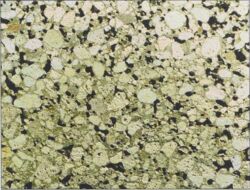KLB Light-weight Concrete
What is light-weight concrete and what does it con-sist of?
The products in the KLB modular construction system belong in the group of light-weight concretes. While normal concretes contain dense additions such as gravel and sand, and are dense-jointed in their structure, light-weight concretes consist of light-weight, porous additions (pumice or expanded clay) and have a porous aggregate material structure.

The raw material grains of the KLB raw material consist of innumerable fine and super-fine pores, which are completely self-contained, with a pore volume of approx. 85 %. The stationary air encapsulated in the pores and the small hollow spaces created between the individual raw material grains, the so-called inter-particle voids, which also harbour stationary air, are the bases for the extraordinarily good, building physics, in particular thermal insulating properties of the KLB products.
Due to the high pore volume large-format blocks can be manufactured, which nevertheless can be processed and worked on handily and easily. Of course, high compressive strength and thereby stability is guaranteed. So the ideal raw material for good wall material is porous, light-weight, with high particle strength and not flammable. The KLB raw materials natural pumice and expanded clay possess these characteristics. They are nearly comparable raw materials with excellent building physics and environmentally friendly characteristics.
The creation of pumice in Germany goes back to a violent volcanic eruption, which took place approx. 13,000 years ago. The centre was in today’s basin of Lake Laach. The highly pressurised molten rock coming from the interior of the earth relaxed while ascending to the surface of the earth due to the quick expansion of the enclosed gases. During the simultaneous hardening the approx. 1200°C hot magma cooled off forming pores. The ejected volumes flung by the eruption up to a height of several kilometres, in particles of 1 to 40 mm, rained onto an area of about 200 km2 in size, today’s Koblenz-Neuwieder basin, and reached layer thicknesses up to 6 m. This pumice is the only occurrence on the European continental shelf. Additional outcrops of pumice can be found on islands like Iceland, the Azores, Teneriffa, Sicily, Yali and Nisyros or in the Asian part of Turkey. Since the German outcrop of pumice is limited, foreign pumice, mainly from states neighbouring the Mediterranean Sea, are imported to preserve resources and used for production.
The volcanic origin gave the pumice characteristic properties, e.g. the multitude of pores and the self-contained cells effect a high degree of porosity with simultaneous high particle strength. In addition, pumice is frost resistant, fire retardant and weather resistant and free of water soluble salts.
To preserve resources expanded clay is also used in small quantities. Expanded clay is based on pumice. It is the result of prepared, granulated short clay, which forms pumice-like pores in a special process at a temperature of approx. 1200°C. The granulated clay balls expand five-fold in volume, and the surface contains a relatively firm, sintered outer skin.

